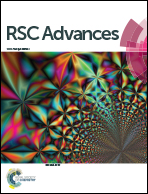Confining the polymerization degree of graphitic carbon nitride in porous zeolite-Y and its luminescence
Abstract
Graphitic carbon nitride (g-C3N4) has aroused broad interest in the field of photocatalysis and luminescence as a kind of metal-free semiconductor with a suitable band gap of ∼2.7 eV. The properties largely depend on the polymerization degree of g-C3N4. This research exploits the nanocages of zeolite-Y to confine the polymerization of the melamine monomer to form g-C3N4. The composites are achieved via a facile two-step method, i.e., melamine–Na+ ion exchange reaction in the cage of the zeolite and subsequent calcination. BET measurement and transmission electron microscopy (TEM) confirm that the g-C3N4 is encapsulated in zeolite-Y, and the polymerization degree can be controlled by the melamine contents exchanged with Na+ in the cages of zeolite-Y. Photoluminescence and vibration spectroscopy also show the features of g-C3N4 with different polymerization degrees in the zeolite-Y composites. This research gives a perspective of fabricating subnanoscale g-C3N4 in porous zeolite, which may find potential applications in photocatalysis and optoelectronics.



 Please wait while we load your content...
Please wait while we load your content...